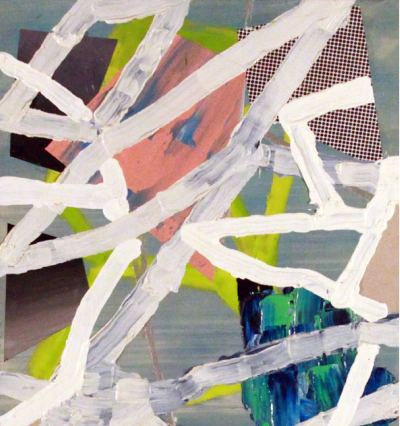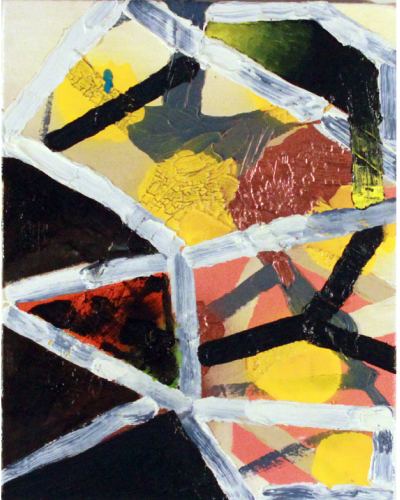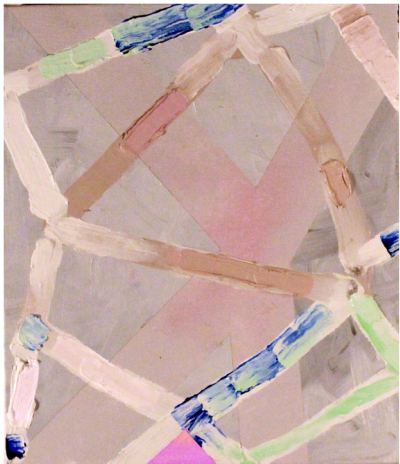If geometry were capable of taking its own rules lightly, mathematics would be at home in the paintings of Alexander Kroll.
They look as if they long to be grids but cannot pass the sobriety test.
 Kroll works small, usually in oil and enamel but occasionally with some element of collage. Ambitious paintings that span no more than two joined hands used to be unusual, back when Thomas Nozkowski was consistently underrated for producing them. He said a single 16 x 14 inch painting could fill a wall but didn’t insist on having a wall for each one, and that was also held against him. (No ego, no glory.)
Kroll works small, usually in oil and enamel but occasionally with some element of collage. Ambitious paintings that span no more than two joined hands used to be unusual, back when Thomas Nozkowski was consistently underrated for producing them. He said a single 16 x 14 inch painting could fill a wall but didn’t insist on having a wall for each one, and that was also held against him. (No ego, no glory.)
Since the mid-1990s, thanks in part to Nozkowski, big no longer has a corner on best. If we’re not quite at William Blake’s definition of enlightenment, to see eternity in a grain of sand, we generally accept that a painting of modest dimensions can possess an enormous sense of scale.
 Some look at Kroll’s work and see nothing but sources: He owes everything to Gerhard Richter, they say. He’s Terry Winters without the seedpods. Doesn’t Tomory Dodge do this better?
Some look at Kroll’s work and see nothing but sources: He owes everything to Gerhard Richter, they say. He’s Terry Winters without the seedpods. Doesn’t Tomory Dodge do this better?
A friend asked that question about Dodge at Kroll’s James Harris Gallery opening, not loudly, to be boorish, but in the spirit of evidence proffered toward a conclusion already reached: not that good. I could have said I thought Dodge leaned more toward Richter and Kroll toward Nozkowski but didn’t. What I wanted to say was an unacceptable question: What is it that you are seeing? Can you see these particular paintings? Can you forget pedigree for a moment and let the moments the paintings themselves create carry you toward their own conclusions?
Broad yet broken diagonals crisscross the surface, creating a foreground that serves as a failed barrier, a collapsed grid. Behind it is the kind of push-pull the Abstract Expressionists used to advocate, an animated, energy exchange carried by color.There’s nothing earth-shaking in Kroll’s premises, but their elaborations are a rare and engrossing pleasure.
 Through March 27.
Through March 27.



Seriously. times are hard. and all you got is some sqwiggles? well good luck college grad.
the ability to peg is only impressive in the bedroom.
“What is it that you are seeing? Can you see these particular paintings? Can you forget pedigree for a moment and let the moments the paintings themselves create carry you toward their own conclusions?”
Black pots and kettles and all that…
Words to live by the next time we read in a post, “this piece looks like this piece,” “artist X got there before artist Y,” or “artist Q owes artist Z everything.”
Words to die by if we are ever hope to really “see” or advance the dialog about what it means to be making art right now.
Hi Sandy. Point taken. I contradict myself. Each person looking at a work of art decides what kind of context is important. Sometimes, for me, it’s important to point out why somebody’s work is overshadowed, supported and/or inspired by another’s. The second person to do Clown Torture does not have the floor to him/herself. In the case of the conversation about Alexander Kroll, however, I felt the comparisons functioned as dismissals, unfair dismissals, because they weren’t specific to the paintings on the wall.